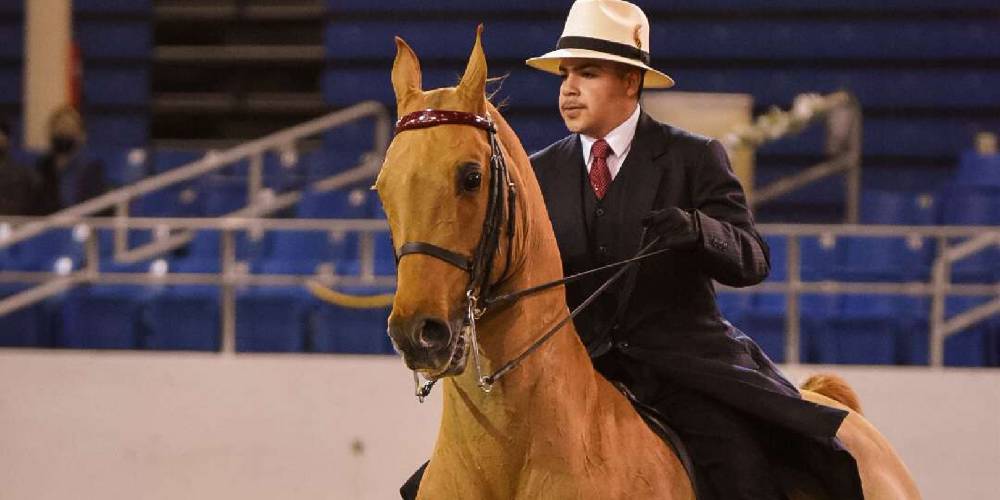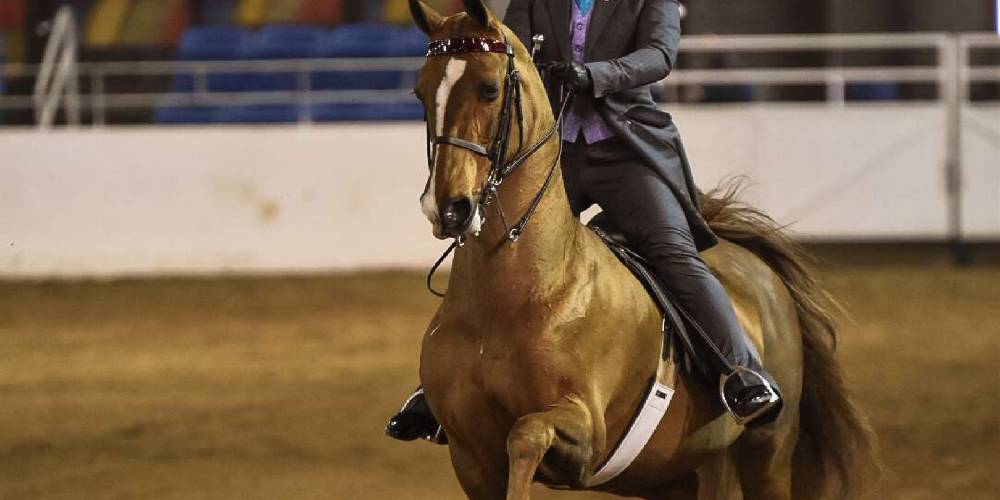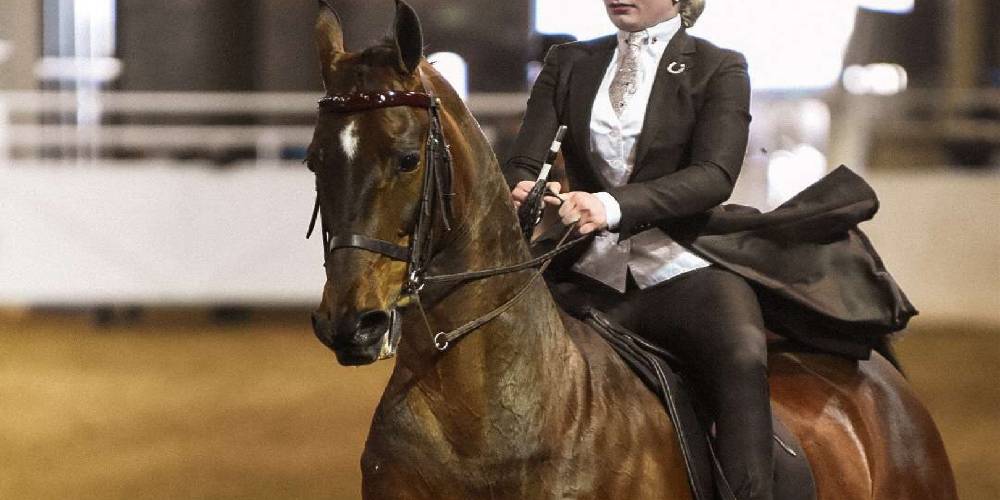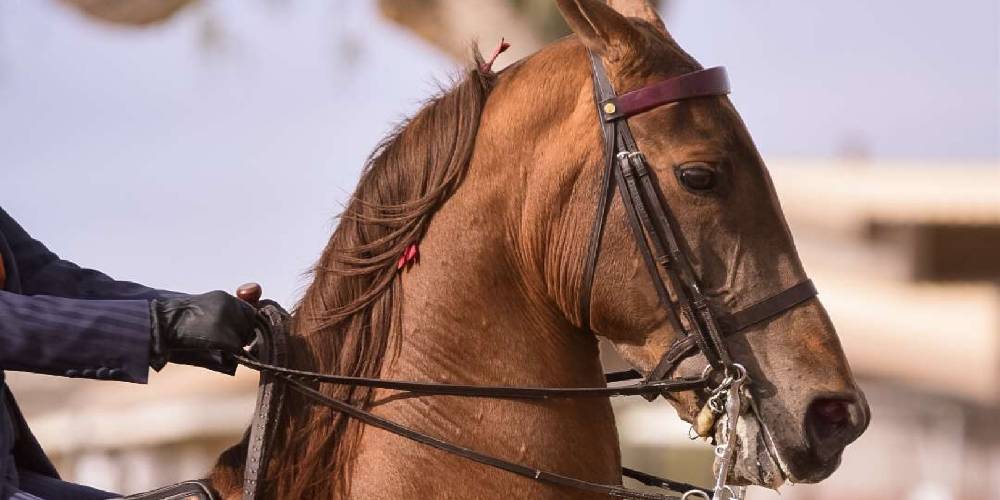The American Saddlebred, usually just known as the Saddlebred, is an American Warmblooded breed known for its high-stepping gait and powerful front action. There are several different things that make this breed unique. One example of what makes this breed unique is its ability to learn a fifth gait called the rack.
What Is The American Saddlebred?
The American Saddlebred is a warmblooded breed of horse that originated in the United States of America, specifically in Kentucky. This breed is known for its high front action, its ability to learn and perform a fifth gait known as the rack, and its exaggerated movement. The Saddlebred is an average-sized horse in both height and weight and they are most commonly seen as chestnuts. Being one of the most famous American horses, this calm and handsome horse earned its reputation in the show ring ridden in a flat saddle.
How Big Is The American Saddlebred?
The Saddlebred is actually not a very big horse and only stands between 15 and 16 hands high. The reason they are thought to be much bigger than they actually are is because of their high head carriage. The way these horses hold their heads makes them appear much taller than they actually are.
The Saddlebred weighs between 1,000 and 1,200 pounds which is roughly average for their size. Depending on their size and body condition they may weight more or less than this number.
What Colors Can Saddlebred Horses Be?

The most common color to see the American Saddlebred as is chestnut. They can be any shade of chestnut as well, from sorrel to liver. This breed can come in any solid color as well including:
- Chestnut (Sorrel, Liver, Flaxen, and Light chestnuts are all potential colors)
- Bay (Dark, Black, and Blood bays are all potential colors)
- Black
- Gray (Dappled and Fleabitten grays are acceptable)
- Palomino
- Buckskin
Some horses shown in Saddlebred classes are only half Saddlebreds and can come in patterns like Overo, Tobiano, and Tovero.
The History Of The American Saddlebred
The American Saddlebred is a relatively new breed as compared to more ancient horses like the Arabian or Barb. This breed was first developed in Kentucky, USA, and was used as any other horse would be for riding and driving. The first two breeds crossed to begin the creation of this breed were the Canadian Pacer and the Narragansett Pacer. Both of these founding breeds are now extinct.
There were many other breeds added to the Saddlebred bloodline to create the breed we known today. The introduction of Morgan blood brought much of the Saddlebred’s proud and majestic appearance to the line. Hackney blood made the horse a little lighter and increased the breeds exaggerated movement and gaits. The Thoroughbred brought energy and conformation to the breed. All together, the Pacers, Morgan, Hackney, and Thoroughbred created the first Saddlebreds.
Once the first Saddlebreds were created, it was found they could learn the rack and the slow gait which are two gaits the Saddlebred can be trained to perform.
How To Identify The Saddlebred

Head
The Saddlebred has a plainer head than most breeds and it is relatively long and flat. Their eyes are usually kind and expressive and their ears are of good size and are neat and pricked.
Neck
The American Saddlebred has a long neck that is set high on its shoulders to allow for more front action. The neck is strong and arched over and meets the head neatly.
Movement
A Saddlebred can be identified by its high motion and front action. Even if the horse isn’t picking up its legs high, it naturally has an extended gait. The Saddlebred moves fluidly and smoothly and by this it can be identified.
Tail
The Saddlebred has an artificial high tail carriage. This is done by cutting or breaking the tail when the horse is at a young age, and putting it into a tail set harness so it heals in the upright position. Saddlebreds don’t require the tail to be broken or cut, but a tail set may be needed, After a while of wearing the tail set harness, the Saddlebred will learn to hold its tail up in the desired position. The harness will need to be worn periodically to maintain the tail position so the tail doesn’t fall to the side. Saddlebred trainers and riders both say that this is not a painful practice.
Back & Croup
The back and croup of this breed are noticeably level with each other. After the withers, the horse’s back seems to run back flat all the way to the horse’s hindquarters.
Temperament
Though this breed looks flashy, fiery, and impressive in the ring, Saddlebreds are actually really calm and docile horses. They like people and want to please their handlers. When they are asked to do something they do it and because they are also energetic horses, they do great in high-action classes like Saddleseat.
What The Saddlebred Excels In

Saddle Seat
Saddlebreds are mainly used for showing in a discipline known as Saddle Seat. Saddle Seat is a class that is shown in two ways: three-gaited and five-gaited. In all Saddle seat classes, a flat saddle is used where the rider sits back nearly on the end of the back and the loins of the horse. Most of the time, Saddlebreds are shown in this class using no saddle pad. Riders in this class are expected to sit upright, maintain control of their mount, keep their legs off the horse, and hold their reins at chest level. Saddle Seat is unlike any other English class that I have witnessed.
In a three gaited class, any Saddlebred qualified to show can compete. The three-gaited classes ask riders to show their horses at the walk, trot, and canter.
In a five gaited class, only Saddlebreds who have been trained to do the rack and slow gait can compete. The horses in these classes will show the walk, trot, canter, slow gait, and rack.
In these classes, Saddlebreds are fitted with heavy shoes to encourage them to lift their legs higher for show.
Driving
Sometimes, Saddlebreds are seen driving carts or carriages. Some Saddlebred shows will have classes where drivers can show their horse pulling. This breed makes a very flashy driving horse just like its distant relative the Hackney.
General Riding
Typically these horses are very smooth to ride and make great pleasure horses. Sometimes Saddlebreds are used for lessons because of their calm temperament and smooth gaits.
I once rode a Saddlebred used for lessons and he was the smoothest horse I have ever ridden!
Trail Riding
Occasionally you might see these horses used for trail riding. This is because, like I said before, they are very calm and smooth horses making them an ideal mount for trail riding.
Why Do Riders Sit So Far Back On Saddlebred’s Backs?

When watching a Saddlebred being ridden, you might notice that the rider will sit pretty far back on the horse’s back, but why is this?
The reason for them sitting so far back on the horse is to take the weight off the horse’s front end to allow maximum leg movement and front action. The horse wouldn’t be able to lift their legs so high if the rider was sitting just behind the withers like in most other classes.
How Long Do American Saddlebreds Live?
Saddlebred horses live to be between 25 and 30 years old which is average for horses of their size and type. The reason they don’t live longer than this is partially because of the way they are ridden. Saddle Seat riders ride the horse on the weakest part of the horse’s back making their back deteriorate faster. The weighted shoes may also affect their soundness creating issues in their health that may shorten their lifespan.
Fun Facts On Saddlebreds
- Saddlebreds are sometimes known as Kentucky Saddlers
- Chestnut is the most common color for these horses
- Saddlebreds are frequently crossed with Arabian horses
All images in this article were taken by Mollie Jones. Check out her Instagram @molliejphotos to see more beautiful horse photography

